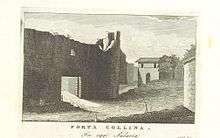Battle of the Colline Gate (82 BC)
| Battle of the Colline Gate | |||||||
|---|---|---|---|---|---|---|---|
| Part of Sulla's second civil war | |||||||
 Porta Collina | |||||||
| |||||||
| Belligerents | |||||||
| Sullans | Marians | ||||||
| Commanders and leaders | |||||||
|
Lucius Cornelius Sulla Quintus Caecilius Metellus Pius Quintus Lucretius Ofella Marcus Licinius Crassus |
Gaius Marcius Censorinus Pontius Telesinus† Gaius Carrinas† Marcus Lamponius | ||||||
The Battle of the Colline Gate, fought on the Kalends of November, 82 BC,[lower-roman 1] was the final battle of the second civil war between Lucius Cornelius Sulla and the Marians. Sulla won and secured control of Rome and Italy. Appian is the only source who provides details about the battle. Much of the war was fought in northern Italy. The Lucanians, the Samnites and the Gauls fought alongside the Marians. Following defection of the Gauls to the forces of Sulla and the defeat of some of his forces by Lucullus (one of Sulla's lieutenants) near Placentia (Piacenza), Carbo, the leader of the Marians, fled to Africa. His lieutenants, Gaius Carrinas, Gaius Marcius Censorinus and Damasippus tried to force their way though a pass controlled by Sulla's men with all their forces and with the Samnites. This failed and they marched on Rome. Sulla sent his cavalry ahead to hinder their march and went to Rome with his army. He encamped at the Colline Gate. The enemy was already encamped nearby. In the ensuing battle Sulla won on the right wing (commanded by Marcus Licinius Crassus), but the left wing was defeated and fled to the gates pursued by the enemy. The soldiers guarding the gate dropped the portcullis (a heavy grating which can be lowered to block the gate) when they saw the rush to the gate, killing many soldiers and many senators. The rest of the Sullans turned and fought the enemy. The battle continued through the night. Gaius Carrinas, a Marian commander, and Pontius Telesinus, the Samnite commander, were killed and their camp was seized. Eventually, the enemy fled. The death toll was estimated at 50,000. There were 8,000 prisoners. They were shot down by darts because they were mostly Samnites. Marcius, Carrinas and Marcus Lamponius, the Lucanian, fled. Marcius and Carrinas were captured and brought in the next day. Sulla killed them. He sent his lieutenant, Lucretius, to show their heads before the walls of Praeneste (Palestrina), where Gaius Marius the Younger was besieged.[1] Velleius Paterculus wrote that Sulla ordered the head of Telesinus to be carried around the walls of Praeneste fixed on top of a spear. He did not mention Marcius and Carrinas.[2]
The people of Praeneste understood that the Marian army had been destroyed and that Sulla controlled Italy. They surrendered. Marius hid in an underground tunnel and committed suicide. His head was cut off and displayed in Rome. Some senators who had held command under Marius were killed by Sulla when he reached Praeneste and some were imprisoned. The inhabitants were divided into Romans, Samnites, and Praenestians. Then a herald told the Romans that they deserved to die but they were pardoned. The men of the other two groups were killed. Norba, a town which still resisted was taken by treachery. The inhabitants strangled themselves with ropes or fell on each other's swords. Others set fire to the town.[3]
Footnotes
- ↑ November 1. The date is given by Velleius Paterculus.
References
Further reading
- Appian, The Civil Wars, Book 1, Penguin Classics; New Edition 1996; ISBN 978-0140445091